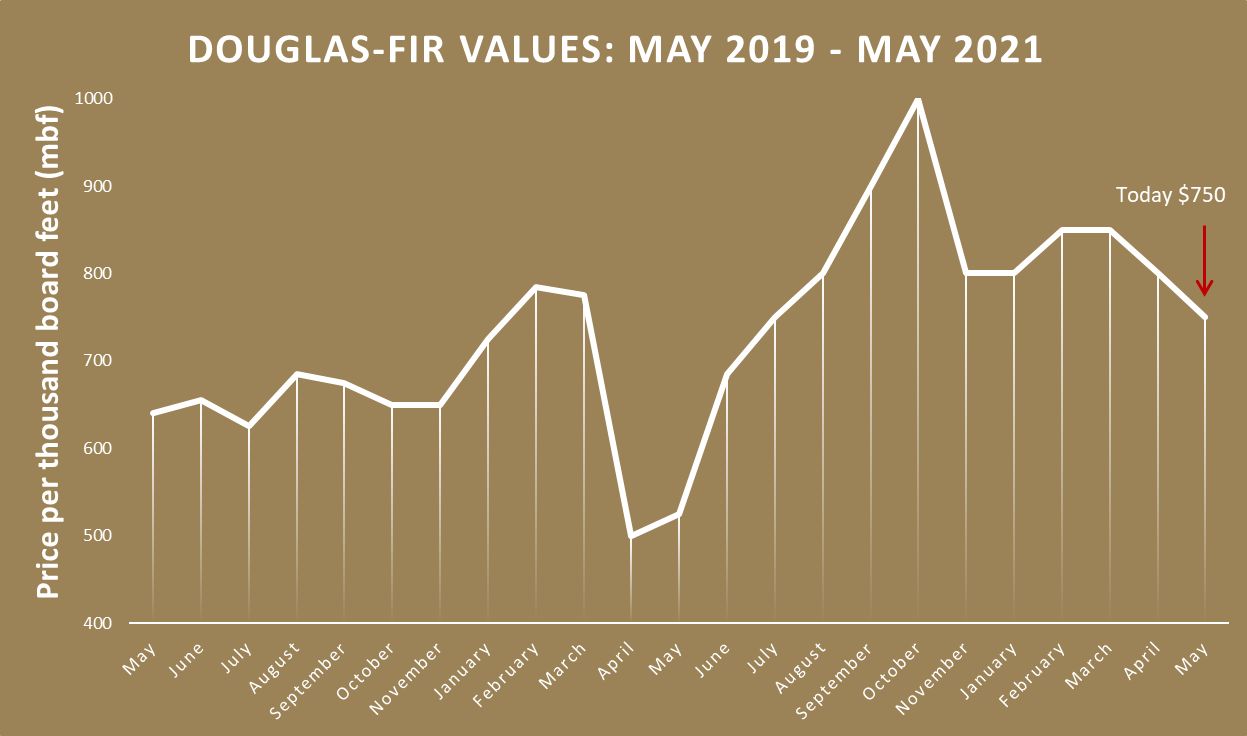By Lauren Grand, OSU Extension Forestry & Natural Resources, Lane County
Summer came early this year. While that is good news for those of you that are looking for an excuse to spend more time out in your woods, unfortunately, it also usually means lowering log prices. “But Lauren, lumber prices are still breaking records, shouldn’t log prices be high too?” Yes, normally. That’s why we saw such high prices last fall. However, thanks to the Labor Day fires, there is an abundance of wood coming to the mills. This along with our early summer means more access to burned areas that were not salvageable in the winter. With inventories this high, some mills are off the market until they can work through what they’ve already got. For these reasons, Douglas-fir prices have been slowly decreasing to today’s prices.
Mills are still taking both green and burned wood, but no charred wood. Green wood is fresh cut timber that was not burned in a fire. Burned wood is timber that burned in the fire, but only the bark, not the wood, was damaged. Charred wood is timber that was in the fire and both the wood and the bark was damaged. In the fire world, high winds make the fire behavior more intense and the fire harder to fight. The silver lining here is that because of the winds, the fire moved so fast that it mostly
burned and scorched the trees and didn’t do as much consumption. This means that unless the trees had spike knots or previous scars, it is unlikely that you have a lot of charred wood on your hands and most of it is in the burned category. If your burned wood is on the smaller side, 5-7 inches, you’ll be hard pressed to find a buyer. These logs are plentiful and, in some cases, starting to degrade.

Now for the meat. Green wood Douglas-fir prices are currently sitting in the $750/mbf range, with a $25-$50 discount for burned wood. Lower than prices you saw last fall, but still higher than historic summer prices.
Chips haven’t been exciting in the recent past, and this quarter is no different. There seems to be a steady stream of chips coming as byproduct from the lumber mills to satisfy most of the fiber market in the area, but there is still a market. Right now chips are in the $20-$25 per ton range.
The current pole market is good, and buyers are taking burned wood, but no char. Short poles are fetching prices in the $850- over $900/mbf range and long poles are $1000-1200/mbf range.
The Hem-fir sorts (spruce, hemlock, grand and white fir) are holding steady this quarter but if you search, you might find some good prices. I’m seeing prices in the $500 – $600 per thousand range if you are in the Roseburg area and $100 lower in the Eugene area.
Alder market is one the rise since lumber prices are doing much better. Mills are buying and prices are looking better than they have been in a while. They are up a bit from last quarter and are sitting in the $600-$700/mbf range.
Redcedar prices are holding steady in the higher portion of their range and are in high demand fetching well over $1000/mbf, in the Eugene area and $900 in the Roseburg area. Incense-cedar on the other hand is holding steady. If you are in the Eugene area you are looking at $550/mbf and for Douglas County area, it’s around $650/mbf. Port-Orford-cedar prices are holding steady in the $400 – $600 range.
Oregon grape is selling for around $0.70 a pound green. It’s best to get the product to your buyer within 2-3 days from harvest. There is a premium for certified organic. Usnea lichen is still sitting pretty at $5.50 per clean and dry pound. Cascara bark is also currently being purchased and will fetch you $0.45/lb green and $1.20/lb “potato chip” dry.
Well, some prices are looking great while others are so-so. If your Douglas-fir is green you might be more interested in playing the market a bit. If lumber prices stay high, you might wait until log prices start to reflect lumber prices a bit better if inventories start to decrease. Though it is unclear how long we’ll see these high lumber prices. If your wood is burned, it’s really now or never. Once the wood degrades you are out of luck when it comes to a dollar value, but if left on site there may be wildlife value instead. If you plan to harvest, note that loggers will be in high demand since there is still a lot of fire salvage clean up to do. Make sure to find your logger early and be a bit flexible. Good luck and always remember to get your purchase order before you cut!


